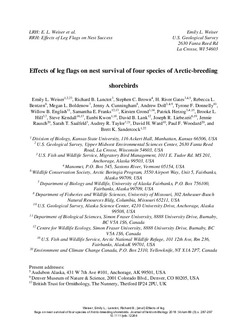Effects of leg flags on nest survival of four species of Arctic-breeding shorebirds
Weiser, Emily L.; Lanctot, Richard B.; Brown, Stephen C. W.; Gates, H. River; Bentzen, Rebecca L.; Boldenow, Megan L.; Cunningham, Jenny A.; Doll, Andrew; Donnelly, Tyrone F.; English, Willow B.; Franks, Samantha E.; Grond, Kirsten; Herzog, Patrick; Hill, Brooke L.; Kendall, Steve; Kwon, Eunbi; Lank, David B.; Liebezeit, Joseph R.; Rausch, Jennie; Saalfeld, Sarah T.; Taylor, Audrey R.; Ward, David H.; Woodard, Paul F.; Sandercock, Brett
Journal article, Peer reviewed
Accepted version

Åpne
Permanent lenke
http://hdl.handle.net/11250/2573273Utgivelsesdato
2018Metadata
Vis full innførselSamlinger
- Publikasjoner fra CRIStin - NINA [2364]
- Scientific publications [1392]
Sammendrag
Marking wild birds is an integral part of many field studies. However, if marks affect the vital rates or behavior of marked individuals, any conclusions reached by a study might be biased relative to the general population. Leg bands have rarely been found to have negative effects on birds and are frequently used to mark individuals. Leg flags, which are larger, heavier, and might produce more drag than bands, are commonly used on shorebirds and can help improve resighting rates. However, no one to date has assessed the possible effects of leg flags on the demographic performance of shorebirds. At seven sites in Arctic Alaska and western Canada, we marked individuals and monitored nest survival of four species of Arctic-breeding shorebirds, including Semipalmated Sandpipers (Calidris pusilla), Western Sandpipers (C. mauri), Red-necked Phalaropes (Phalaropus lobatus), and Red Phalaropes (P. fulicarius). We used a daily nest survival model in a Bayesian framework to test for effects of leg flags, relative to birds with only bands, on daily survival rates of 1952 nests. We found no evidence of a difference in nest survival between birds with flags and those with only bands. Our results suggest, therefore, that leg flags have little effect on the nest success of Arctic-breeding sandpipers and phalaropes. Additional studies are needed, however, to evaluate the possible effects of flags on shorebirds that use other habitats and on survival rates of adults and chicks.